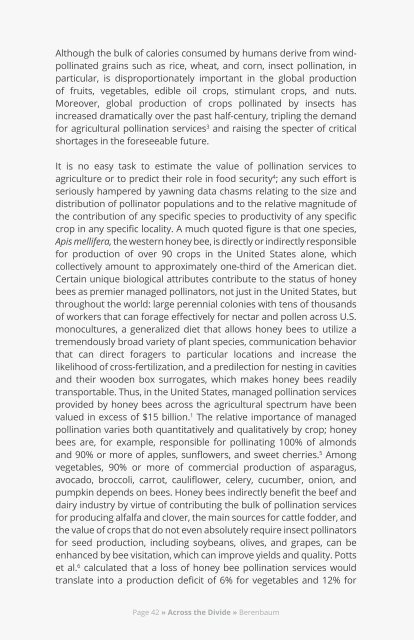3xxLTp
3xxLTp
3xxLTp
You also want an ePaper? Increase the reach of your titles
YUMPU automatically turns print PDFs into web optimized ePapers that Google loves.
Although the bulk of calories consumed by humans derive from windpollinatedgrains such as rice, wheat, and corn, insect pollination, inparticular, is disproportionately important in the global productionof fruits, vegetables, edible oil crops, stimulant crops, and nuts.Moreover, global production of crops pollinated by insects hasincreased dramatically over the past half-century, tripling the demandfor agricultural pollination services 3 and raising the specter of criticalshortages in the foreseeable future.It is no easy task to estimate the value of pollination services toagriculture or to predict their role in food security 4 seriously hampered by yawning data chasms relating to the size anddistribution of pollinator populations and to the relative magnitude ofApis mellifera, the western honey bee, is directly or indirectly responsiblefor production of over 90 crops in the United States alone, whichcollectively amount to approximately one-third of the American diet.Certain unique biological attributes contribute to the status of honeybees as premier managed pollinators, not just in the United States, butthroughout the world: large perennial colonies with tens of thousandsmonocultures, a generalized diet that allows honey bees to utilize atremendously broad variety of plant species, communication behaviorthat can direct foragers to particular locations and increase thelikelihood of cross-fertilization, and a predilection for nesting in cavitiesand their wooden box surrogates, which makes honey bees readilytransportable. Thus, in the United States, managed pollination servicesprovided by honey bees across the agricultural spectrum have beenvalued in excess of $15 billion. 1 The relative importance of managedpollination varies both quantitatively and qualitatively by crop; honeybees are, for example, responsible for pollinating 100% of almonds 5 Amongvegetables, 90% or more of commercial production of asparagus, dairy industry by virtue of contributing the bulk of pollination servicesfor producing alfalfa and clover, the main sources for cattle fodder, andthe value of crops that do not even absolutely require insect pollinatorsfor seed production, including soybeans, olives, and grapes, can beenhanced by bee visitation, which can improve yields and quality. Pottset al. 6 calculated that a loss of honey bee pollination services would Page 42 » Across the Divide » Berenbaum


